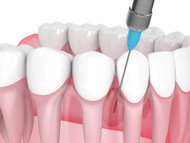Septocaine (Articaine) Dental Local Anesthetic: Effects, Usage, Applications
Posted by Dental Didactics CE: Dental Board of California Registered CE Provider #RP3768, Academy of General Dentistry National PACE Provider #217643 on Nov 6th 2022
Uses of Septocaine:
Although lidocaine 2% with epinephrine 1:100,000 is currently the most commonly used local anesthetic for dental procedures in the United States, Septocaine 4% with epinephrine 1:100,000 is growing in popularity. It was developed in Germany in 1976 and has recently received FDA approval for use in the United States. Common usages include dental restorative procedures, dental surgeries, and endodontic treatment. It is utilized when more profound and extended anesthesia is desired, especially in the mandible where infiltration anesthesia with lidocaine is usually inadequate due to mandibular bone density. Septocaine can often achieve adequate mandibular anesthesia with only an infiltration approach, eliminating the need for a mandibular block.
Articaine and Septocaine confused:
There is some confusion regarding the local anesthetic articaine. Articaine is actually the generic name for Septocaine, which is a registered trademark of Septodont, Inc. The exclusive patent for Septocaine has expired and generic articaine can now be ordered in place of the brand name anesthetic.
Side Effects of Septocaine
The clinical drawbacks to Septocaine use include:
- prolongeded anesthetic effect (which can result in cheek and lip biting, especially in pediatric and elderly patients)
- expanded local anesthetic effect (if given in the maxillary arch the anesthetic effect can spread to the orbit of the eye, etc.)
- increased reports of mandibular paresthesia when utilized for mandibular block injections (attributed to the higher 4% concentration of the anesthetic)
Chemical Composition and Mechanism of Action
Although similar in chemical structure to amide-type local anesthetics (like lidocaine), Septocaine's structure differs slightly as it incorporates:
- an ester linkage
- a thiophene ring replacing a benzene ring
Septocaine's mechanism of action is similar to other local anesthetics with its primary action being the reversible blockage of the generation and propagation of neural impulses. This is accomplished by:
- increasing the firing threshold of electrical excitation innerves
- slowing the rate of rise of the action potential
- diminishing the propagation of nerve impulses
The specific mechanisms of action are related to Septocaine's binding effect on neural membranes which:
- binds to sodium (Na+) ion channels in the nerve membrane
- decreases permeability of the membrane to sodium (Na+) ions
- inhibits sodium (Na+) ion inflow during depolarization
- inhibits potassium (K+) ion flow outward
For an in-depth discussion of this unique dental local anesthetic see our Septocaine CE course

